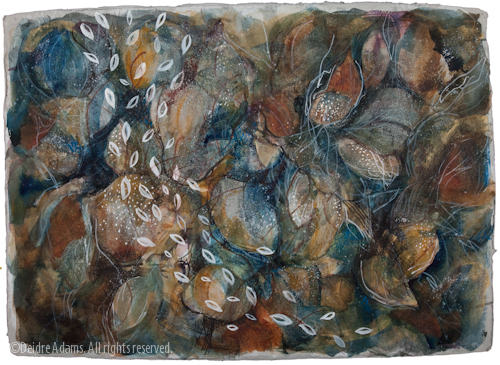Opportunity Cost
 Kitchen, 36 x 36 inches, acrylic & oil on canvas, ©2007 Deidre Adams
Kitchen, 36 x 36 inches, acrylic & oil on canvas, ©2007 Deidre Adams
Last Friday was the first day of my last semester in the BFA program at Metro. I’m only taking one class:
ART 4701 – Snr Exp Studio: Portfolio Devl
This studio course requires the student to present finished work in a senior thesis show, produce a slide and/or CD portfolio, and write a concise statement about the intention, and methodology of producing the body of work. This effort will result in the production of a body of work as well as an introduction to the profession of the studio artist.
AKA “BFA Thesis & Portfolio,” this is the class where we wrap it all up, tying together everything we’ve learned, and get pushed out of the nest to sink or swim. (Sorry – couldn’t resist the mixed metaphor.) A major effort of the class involves figuring out what our art is about so that we can write our BFA thesis statements.
By now, it seems we are expected to have settled on a particular media and theme that we want to pursue to the exclusion of all others. This idea is reinforced by the art world in general and the gallery system in particular: once you become known for doing a particular thing, major changes to your style and methods are done at your own peril. Society likes to be able to neatly categorize things, and if you want to sell your work, you need to figure out which box you can be put into.
For me, this whole system is fraught with angst. I’m interested in a wide range of themes — place, time, language, politics, social issues, technology — and I love working with different media — textiles, painting, photography, printmaking, and collage. If I had to choose just one from each column and work only in that way for the rest of my life, it would seriously curtail my interest in making art.
A long time ago, during the course of earning my first degree, I remember learning about the concept of “opportunity cost” — probably in Econ 101 or some other finance-oriented class. Opportunity cost is “The cost of an alternative that must be forgone in order to pursue a certain action. Put another way, the benefits you could have received by taking an alternative action” (Investopedia). It applies to investing because by choosing to put your money into one stock, you have an associated opportunity cost, which is giving up the chance to make money by investing in something else. The idea really struck me, I suppose, because it occurs to me frequently when thinking about what kind of art I want to be making. For instance, if I choose to work on paintings on panels, the opportunity cost is the time I could have spent making textile work. (Or time I could have spent working on my web site or pursuing exhibition opportunities … but I guess I shouldn’t muddy the waters too much.) The opportunity cost of writing this blog post is the time I should be using to complete my assignment that’s due in class tomorrow.
Last night the idea hit me again vividly when I was making salads for dinner.
When I cut into this beautifully formed Roma tomato, I had a strong, visceral impulse: I wanted to immediately drop everything I was doing and start working on a series of huge, close-focus paintings of sliced vegetables. But my inner arbiter of common sense quickly intervened and reminded me that that would be utterly ridiculous. There would be a huge opportunity cost associated with that: I’d be giving up all the time I need to work on the things I’m currently doing.
That’s been one of the very enjoyable luxuries of school — freedom to experiment and try lots of different things without having to feel that I was giving up something. The painting at the top of this post is a good example. It was done in my Painting II class in 2007. I don’t remember exactly what the assignment was, but I know it had something to do with interiors and Cubism. I remember that I enjoyed making this painting immensely, and I would love to make several more in a series of them. But would it really make sense to do that when I also have a strong desire to make more textile work, and in fact have started on a new series in that medum? And when I am simultaneously thinking about my Resonant State series, which was to have been the work for my BFA thesis? (I say “was to have been” because now I’m wavering once again about whether I should really try to incorporate textile work into my thesis.)
Thank goodness we’re doing all this contemplation and introspection in class. I’m more confused than ever.



